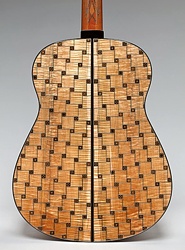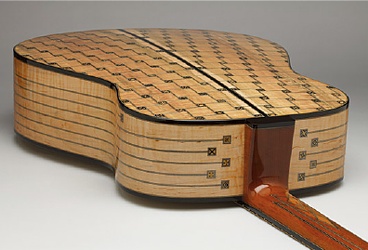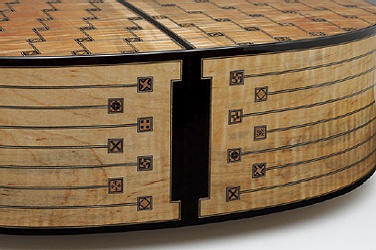March 25, 2011
 Some of you may know that I made a rosewood Andamento guitar about two years ago; it’s a wonder of design and craftsmanship if I do say so myself. The cutting, the inlaying, and the design itself took a long time to execute; and the work also included the design and making of eleven separate rosette logs. It’s the most fancily inlaid thing I’ve ever produced.
Some of you may know that I made a rosewood Andamento guitar about two years ago; it’s a wonder of design and craftsmanship if I do say so myself. The cutting, the inlaying, and the design itself took a long time to execute; and the work also included the design and making of eleven separate rosette logs. It’s the most fancily inlaid thing I’ve ever produced.
I initially thought of making something like this because I liked the design. The idea came from my dropping a spoon while having dinner at a Mexican restaurant; when I leaned over to retrieve it I noticed this same pattern in the floor tiles and was captivated by it. What a lovely pattern! I’ve since learned that this is a fairly common pattern that is used in both floor tiles and textiles. There’s even a picture of Michelle Obama, on the front page of the New York Times, wearing a dress with this print pattern on it! If the first lady is sporting the Andamento pattern, it’s got to be a winner, no?
Of course, the pattern isn’t called the Andamento; that’s a word that my associate Lewis Santer came up with after some research into inlay patterns. It turns out that inlay artists in the Renaissance gave that name to certain of their decorative patterns. Andamento refers to the movement (the going or traveling across) of a decorative pattern, through a material, or across one’s visual field. My guitar’s mosaic pattern has a lot of movement in it, so the name Andamento, invented by Italian craftsmen centuries ago, seemed to fit.
 |
 |
After completing the rosewood Andamento, I then embarked on a second one, in maple. I seemed to have a vague idea of making a matching pair of dark and light wood instruments.
It’s gorgeous, of course, but I learned that doing this kind of work in maple is MUCH more difficult than it is in any dark wood. You can hide mistakes in dark woods; you cannot in maple: any miscut, any splintering, any irregularity, any breakage or tear-out, any subsequent repair… all will be forever visible. If the parts don’t fit perfectly, of if there’s the slightest gap, a glue line that would have been invisible in a dark wood will stand out. White wood is simply unforgiving.
It’s ironic that, because maple is so much cheaper a wood than Brazilian rosewood is, this guitar would ordinarily command a lower value than its rosewood counterpart. But from the standpoint of sheer patient, skilled labor, there’s no comparison: the maple Andamento took significantly longer to execute and make look perfect. My helper Chris Morimoto deserves a lot of credit for this, because without his consummate attention to detail this guitar would have taken twice as long to produce.
Besides the beauty of the maple, this guitar has close to 200 mosaic tiles — of eleven different mosaic patterns — inlaid into it. The tiles are about half the size of a dime and each one is made up of 200 tiny pieces of wood. And then, of course, there are several hundred feet of (mostly) two-inch long inlaid sections of black-white-black purfling, each mitered into and butted against each other.
This needs to be a pricey guitar, for obvious reasons. It is spectacular in photographs and even more so up close. It is available now. If you’re interested, please call or email me for price information.